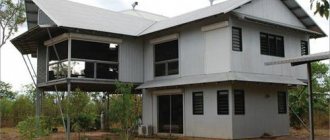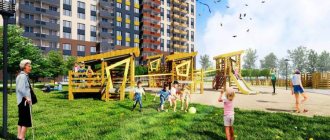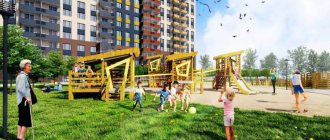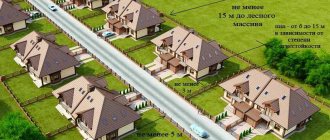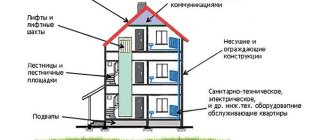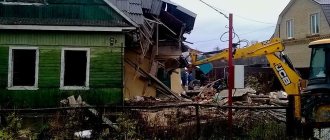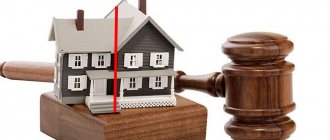There is no strict definition of such a concept as a plot of local area in the legislation. There are different approaches to its explanation, but they are all relative and, depending on the context, have corresponding features. In general, the adjacent area is understood as the territory adjacent to the building, which can be used in the interests of the owner of the structure. Let us next consider the features of this zone.
Local area of a private house
As a rule, this concept is used for multi-apartment residential buildings. The local area of a private house is an area owned by the owner of the building and adjacent to it. The basis for confirming ownership may be a certificate of ownership or a lease agreement. The adjacent territory of a private house, as a rule, is used for maintenance of the structure, landscaping, etc. One of its integral features is fenced off from other plots. This means that the area adjacent to the structure is separated by a fence from neighboring or municipal property.
Disputes about the right to the local area
A new surge of interest in the issue of the rights of residents of apartment buildings (hereinafter - MKD) to the adjacent territory was caused by the appeal ruling of the Moscow City Court dated July 14, 2021 in case No. 33-24329/2020. Residents of the Ostankino district of Moscow filed a claim against the Moscow City Property Department and the Moscow State Enterprise "Civil Construction Administration" to partially challenge the agreement for the gratuitous use of a land plot with an area of 8,600 square meters. m., provided for the construction of a gymnasium (demolition and new construction) as part of the renovation program.
The court of first instance refused to satisfy the citizens' claim for the reason that the land plot under the house was not formed, was not registered in the cadastral register and was owned by the city. Consequently, it does not belong to the common property of the apartment building, therefore its residents are deprived of the opportunity to own and use the site.
The Moscow City Court did not agree with these conclusions, pointing out that the Moscow City Property Department, as a representative of the government body for the management of capital property, does not have the right to dispose of the land provided for the construction and operation of apartment buildings, in the part in which the land plot under the specified apartment building. In turn, the plaintiffs, as owners of premises in an apartment building, have the right to own and use this land plot to the extent necessary for their operation of the apartment building, as well as the objects that are part of the common property in such a house, i.e. within the boundaries in which the local area was previously determined in accordance with the procedure established by law before its formation as a result of land surveying.
The lack of cadastral registration of land plots under MKD is a common phenomenon found everywhere. This is due to the fact that mass housing construction was carried out back in the Soviet years, and systems of cadastral registration and state registration of rights to real estate were introduced only by the end of the 90s. XX century Thus, the USRN information currently contains information only about those land plots that were formed after the creation of this system.
This problem practically does not concern new houses, since after the Housing Code of the Russian Federation came into force (March 1, 2005),1 a house cannot be put into operation if the plot under it has not been formed (not registered with the state cadastral register)2.
Let us note that the conclusions of the Moscow City Court are not fundamentally new, but only repeat those set out in paragraph 68 of the Resolution of the Plenum of the Supreme Court of the Russian Federation and the Plenum of the Supreme Arbitration Court of the Russian Federation dated April 29, 2010 No. 10/22 (as amended on June 23, 2015) “ On some issues that arise in judicial practice when resolving disputes related to the protection of property rights and other real rights”, a position which, by the way, is obligatory for lower courts to follow. Decisions with a similar legal position have been adopted previously.3
Particularly often, disputes about the legality of establishing the boundaries of land plots forming the local area, as well as about the right to dispose of them by public legal entities (a city of federal significance, a municipality) arise in the case of construction under the Renovation program in Moscow.
Such disputes can be divided into four broad categories:
- on the right to dispose of the adjacent territory of the apartment building;
- on the refusal of a public legal entity (city of federal significance, municipal entity, whose competence includes the relevant issue) to ensure the formation of the land plot on which the apartment building is located;
- on the refusal of a public legal entity to carry out the work necessary to form the site;
- on the boundaries of areas intended for the placement of apartment buildings.
To answer the question of how to avoid these problems, you must first decide what area and what local area we are talking about.
What is meant by the land plot of a residential building and the surrounding area?
This is a plot of land on which an apartment building with elements of landscaping and improvement is located, as well as other objects intended for the maintenance, operation and improvement of this house (Clause 4, Part 1, Article 36 of the Housing Code of the Russian Federation). The boundaries and size (area) of the plot on which the house is located are determined by state authorities or local government in accordance with their competence, as well as the requirements of land legislation and legislation on urban planning.
Let us note that in the case of the formation of a land plot under an apartment building, it is likely that its boundaries will be determined in accordance with the actual land use. This was previously stated by the Judicial Collegium for Administrative Cases of the Armed Forces of the Russian Federation in the Cassation Ruling of May 27, 2021 No. 89-CAD20-1-K7. In this case, the period of actual land use of the territory on which MKD4 is located is important.
In accordance with judicial practice, the land plot formed under the house must include: landscaping facilities for the courtyard area, a gas tank, a utility area for drying clothes, mailboxes, a children's and sports grounds, and landscaping5.
To justify the boundaries of the plot being formed, residents of apartment buildings can rely on the Methodological recommendations for carrying out work on the formation of land plots on which apartment buildings are located, approved by Order of the Ministry of Construction of Russia dated March 7, 2021 No. 153/pr, as well as Methodological instructions for calculating the standard sizes of land plots in condominiums, approved by Order of the Ministry of Land Construction of the Russian Federation dated August 26, 1998 No. 59. According to judicial practice, a condominium is a guarantee of the rights of owners to purchase a land plot occupied by a house.
If the boundaries of the site for the MKD are not formed...
Based on the principle of the unity of fate of land plots and objects firmly associated with them, the Constitutional Court of the Russian Federation in Resolution No. 12-P of May 28, 2010 (hereinafter referred to as Resolution KS No. 12-P) indicated that in order to ensure the rights of owners of residential and non-residential premises in such houses, the Housing Code of the Russian Federation establishes a general rule that the plot belongs to the owners of the premises in the house located on it (Parts 1 and 2 of Article 36 of the Code). At the same time, the Introductory Law defines the special procedure and conditions for the transfer of such a site into the common shared ownership of the owners of premises in the apartment building that is located on it.
In accordance with the specified procedure, the transfer of a land plot into common shared ownership is associated with the completion of the process of its formation and state cadastral registration. At the same time, any acts of state bodies or local governments on the provision of a land plot or on the emergence of ownership rights, as well as state registration of the right of common shared ownership of a plot in the Unified State Register of Real Estate, are not required.
If the plot is not formed and is not registered in the cadastral register, the land under the MKD is the property of the corresponding public legal entity. In turn, the owners of premises in the house have the right to own and use this site to the extent necessary for the operation of apartment buildings, as well as objects that are part of the common property. When determining the limits of the powers of the owners of premises in an apartment building for the possession and use of the specified site, it is necessary to be guided by Part 1 of Art. 36 Housing Code of the Russian Federation.
Thus, if the site under a residential building is not registered in the cadastral register, this does not deprive the owners of the premises in it of the right to use the adjacent territory, including for the installation of fences and barriers (Appeal ruling of the Supreme Court of the Republic of Bashkortostan dated June 21, 2021 in case No. 33 11827/2016).
From the moment of formation of the site and its cadastral registration, the land plot on which the MKD and other real estate included in it are located passes free of charge into the common shared ownership of the owners of the premises in the MKD (Part 5, Article 16 of the Introductory Law).
According to Art. 305 of the Civil Code of the Russian Federation in these cases, the owners of the premises, as the legal owners of the land plot on which the house is located and which is necessary for its operation, have the right to demand the elimination of any violations of their rights of ownership and (or) use of this plot, including from its owner. They also have the right to challenge in court, taking into account the jurisdiction of cases according to the rules of Chapter. 25 Code of Civil Procedure of the Russian Federation or Ch. 24 of the Arbitration Procedure Code of the Russian Federation actions (inaction) of the government authority on the formation of the land plot on which the residential building is located, the development of documentation for the planning of the territory (Articles 45 and 46 of the Town Planning Code of the Russian Federation), as well as actions preceding the disposal of the site - in particular, decisions on the provision of the site for construction, bidding for the sale of a site or the right to conclude a lease agreement, etc.
If, as a result of such actions of a government agency, third parties have a right to a land plot necessary for the operation of an apartment building, the owners of premises in the house can file a lawsuit to challenge the corresponding right of third parties or to establish the boundaries of the plot.
Formation of a site for an apartment building
The position set forth in the Resolution of the Constitutional Court No. 12-P is that for the free transfer of the land plot on which the apartment building and other real estate included in it are located into the common shared ownership of the owners of the premises, it is necessary and sufficient for the formation of this plot by public authorities or local government in accordance with the requirements of land legislation and legislation on urban planning activities, as well as registration of the site with cadastral registration
- despite the fact that neither a special decision of public authorities on the provision of a plot, nor state registration of the right of common shared ownership of it in the Unified State Register of Real Estate is required.
According to sub. 4 p. 3 art. 11.3 of the Land Code of the Russian Federation, exclusively in accordance with the approved land surveying project, the formation of plots is carried out within the boundaries of an element of the planning structure built up by apartment buildings (Letter of Rosreestr dated April 11, 2021 No. 14-03826-GE/18 “On the possibility of forming a land plot” together with the Letter of the Ministry of Economic Development Russia dated March 6, 2021 No. D23i-1133).
In other cases, the formation of plots from lands or land plots that are in state or municipal ownership is permitted in accordance with the approved layout of the plot (plots) on the cadastral plan of the territory in the absence of an approved land surveying project.
At the same time, the boundaries of plots under MKD should take into account public lands and should not cross them. Based on clause 12 of Art. 85 of the Land Code of the Russian Federation, public areas are areas occupied by squares, streets, driveways, highways, embankments, squares, boulevards, water bodies, beaches and other objects that can be included in various territorial zones and are not subject to privatization. Otherwise, such a land surveying project may be challenged (see, for example, the Cassation Ruling of the Supreme Court of May 22, 2021 No. 67-KA19-1).
Particular attention should also be paid to the need to comply with all procedures provided for by law aimed at forming a site for an apartment building. In addition, a full survey must be carried out, as well as an objective and comprehensive assessment of the quarter from the point of view of ensuring regulatory sufficiency, functional integrity and admissibility of planning isolation of the allocated plots, and the land surveying project in accordance with which the plot is formed must undergo public hearings (Definition Judicial Collegium for Civil Cases of the Armed Forces of the Russian Federation dated August 6, 2021 No. 5-KG19-140).
At the same time, the appeal of any owner of premises in an apartment building to government agencies with an application for the formation of the land plot on which the house is located should be considered as the basis for the formation of the plot and its cadastral registration
, which does not eliminate the need for the formation and cadastral registration of land plots within a reasonable time by the public authorities themselves, which are entrusted with the corresponding function (Resolution of the Constitutional Court No. 12-P).
Since the formation of the sites on which apartment buildings are located relates to the area of public legal relations, government agencies entrusted with this responsibility do not have the right to arbitrarily refuse to fulfill it if there are all the grounds provided for by law for the formation of the site
(appeal ruling of the Moscow City Court dated May 28, 2021 in case No. 33a-2886; cassation ruling of the Second Cassation Court of General Jurisdiction dated February 5, 2021 No. 88a-1594/2020).
The specified actions (inaction) of the government agency can be challenged by the owners of the premises. The specific procedure for challenging will depend on the method of management of the apartment building (homeowners association, management company, etc.).
1 Article 1 of the Federal Law of December 29, 2004 No. 189-FZ “On the implementation of the Housing Code of the Russian Federation” (hereinafter referred to as the Introductory Law).
2 Part 6 art. 16 of the Introductory Law.
3 Appeal ruling of the Moscow Regional Court dated April 6, 2015 in case No. 33-7685/2015, 33-7992/2015; Determination of the Supreme Arbitration Court of the Russian Federation dated April 19, 2012 No. VAS-4716/12 in case No. A04-1618/2011.
4 Determination of the Supreme Arbitration Court of the Russian Federation of October 1, 2012 No. VAS-12039/12 in case No. A66-10449/2010.
5 Determination of the Supreme Arbitration Court of the Russian Federation dated April 19, 2012 No. VAS-4716/12 in case No. A04-1618/2011.
The local area of a private house: how many meters can it be?
Often there is a need to determine the size of the area adjacent to the structure. There are no specific standards for the local area. For example, the average size of zones adjacent to multi-apartment residential buildings ranges from 3 to 6 m. Of course, the area can be larger. The specific parameters will depend on various factors. The calculation uses the land plan, characteristics of the structure itself, the number of residents, requirements for parking spaces and landscaping.
When establishing a zone, the need to provide a distance for fire exits and urban planning standards established for a particular area are taken into account. As for individual development, the situation here is not so clear. Nevertheless, it is worth saying that when determining the size of zones adjacent to a structure, not as many mistakes are made as in cases with multi-apartment buildings. When a plot plan is drawn up, the area owned is taken into account first. In addition, a distance of 1.5 m from the outer part of the fence is taken into account. It can be considered a local area.
Regulatory regulation
Speaking about the boundaries within which this or that local area is located, it should be noted that this indicator is regulated by the Town Planning Code (in terms of its regulation), the Land Code (in the part in which the actual boundaries of the land plot allocated for a particular house are determined), as well as Federal Law No. 218-FZ “On State Registration of Real Estate” (regarding the procedure for registering a land plot as shared ownership of the residents of the house in question).
Part 1 of Article 36 of the Town Planning Code of the Russian Federation establishes the mandatory presence of town planning regulations in each specific region, as well as in all municipalities in which work is carried out on the construction of various buildings belonging to the residential and non-residential stock. It is these regulations that establish in each city the standards in accordance with which the adjacent area of a particular house is formed.
Article 11.2 of the Land Code describes the list of actions that must be carried out to form a particular land plot, including determining its boundaries.
Chapter 3 of Federal Law No. 218-FZ “On State Registration of Real Estate” describes the detailed procedure necessary for registering a land plot allocated for a local area and recognizing such actions as legal.
Content
When determining boundaries, the subject of dispute may be the question of who will be responsible for maintaining the area adjacent to the structure in proper condition. Cleaning the territory is quite a pressing issue for private owners, especially in the spring-summer period and autumn. As mentioned above, the area adjacent to their buildings extends beyond the boundaries of their own allotment. In this regard, cleaning of the area should be carried out within 1.5 m from the fence.
The area behind the fence of a private house - at what distance should it be kept clean?
Laws at the federal level give general concepts of maintaining the territory in order, but no specifics. In order to find out how many meters from the fence of a private house you need to remove, you should refer to local regulations.
Local rules and decisions contain more specific information; in addition, they should not contradict the law of the subject in whose territory they are located.
For example , your private house is located on the territory of the municipality of Podolsk, Moscow region.
In the Moscow region, the rules for improvement were approved by the Law on Improvement dated December 30, 2014 No. 191/2014-OZ; in Podolsk the rules were enshrined in the Decision of the Council of Deputies dated December 28, 2018 No. 56/13. These two acts practically duplicate each other, except that the decision contains additions regarding local features.
Local Laws and acts define a number of minimum responsibilities for keeping the area outside the fence of a private house clean and tidy, namely:
- mow lawns and other grassy vegetation;
- maintain outdoor utility equipment;
- remove garbage from the area behind the fence;
- maintain the pedestrian road surface in order;
- carry out snow removal;
- do not allow storage of fuel, building materials, fertilizers in the adjacent territory for more than 7 days.
What area in a private house behind the fence needs to be kept clean and in order?
Also, the landscaping rules for the region indicate the specific size of adjacent territories for private owners:
In relation to land plots and territories of individual households - NO MORE than 5 meters from the boundaries of such plots and possessions.
In relation to SNT - NO LESS THAN 5 meters and NO MORE THAN 30 meters of territory behind the fence.
As for dacha plots in SNT, here we are talking about a public territory and rules for footage are established regarding the boundaries of the SNT itself.
Accordingly, the charter of a gardening partnership may stipulate rules for cleaning the area behind the fence of a private house on your site within this area.
But what if the adjacent territory belongs to both one building and another? For example, the area between the fences of two private houses is only 5 meters. How many meters from the fence will need to be removed then? In this case, the adjacent territories are suppressed, and it is divided equitably - half is removed by one owner, and half by the other. At least, according to the law of the Moscow region, such rules apply.
Attention! In your region, the area that must be cleaned outside the fence of your property is regulated by the rules of the local administration and may differ from the example above.
Decor
The adjacent territory of a private house can be transferred into ownership or lease. To do this, you need to obtain the appropriate state registration certificate or enter into an agreement to purchase the part located behind the fence. The latter must be endorsed by the BTI. To register, you should first contact your local authorities. There you need to fill out an application. In addition, it is necessary to provide evidence that the site is abandoned. Usually the decision to assign status is made within 3 weeks. If the answer is positive, information about it is entered into the Unified State Register.
An easement can be established for the passage of citizens through the territory of an apartment building to public places
At a general meeting, the owners of one of the apartment buildings in Izhevsk decided to install a fence with a gate around their yard. The management organization complied with this decision, having previously obtained all the necessary approvals and permits from the municipality.
But residents of the neighboring apartment building complained to the State Housing Authority: the fence blocked their pedestrian path to the public transport stop. The agency inspected the work of the management authority on the maintenance of the common property of the house around which the fence was installed.
The State Housing Supervision Authority came to the conclusion that the territory along which the pedestrian path was laid for residents of the surrounding apartment buildings is burdened with an easement. Owners cannot prevent other citizens from using a pedestrian path by blocking it. Consequently, the decision of the OSS to install the fence was made in violation of Part 5 of Art. 36 Housing Code of the Russian Federation.
The management authority received an order to notify the owners of the premises in the disputed apartment building that the fence violates the law, and to ensure passage through the adjacent territory of the apartment building.
The company filed a lawsuit, demanding that the order be declared illegal and unenforceable. According to the Civil Code of the Russian Federation and the Housing Code of the Russian Federation, owners of premises in apartment buildings have the right to make a decision at the OSS on fencing the local area, which is part of their common property. This is the exclusive competence of the general meeting. The decision was made with the necessary quorum present. When installing the fence, the UO received all the necessary permits. The company should not coordinate such work with residents of neighboring houses.
The State Housing Supervision Authority insisted that the fence creates an obstacle to the use of the pedestrian path. Persons who are not the owners of a land plot retain the right to use the objects on it if they were created before the date of entry into force of the Housing Code of the Russian Federation.
MKD land plot: maintenance and assessment of its sanitary condition
Arrangement
Another quite pressing problem for many private owners is the improvement of the area adjacent to the building. In this regard, experts recommend drawing up a site plan, distributing objects on it at your own discretion. Landscaping involves a certain set of works. It includes:
- Uprooting unnecessary bushes and trees.
- Garbage removal.
- Construction of gazebos, arches, hedges, pergolas.
- Delivery of fertilizers and new land.
- Laying out lawns.
- Creation of flower beds.
- Vertical landscaping of the facade.
- Planting shrubs and trees.
- Construction of a fountain or pond.
- Arrangement of a recreation area and children's playground.
Undoubtedly, not all of these points can be fulfilled. Some work will simply be irrelevant or impractical for one owner or another. The site plan is drawn up taking into account the wishes of the owners. However, no matter how many of the above points are completed, each of them requires a certain amount of time, study, quality preparation, and the purchase of materials and tools. Having certain skills will also be important.
Improvement issues
Requirements for landscaping must be met at least to a minimum extent. Regardless of who exactly owns this or that plot.
Each locality develops its own set of rules. But they always contain common elements based on standard sanitary standards. The minimum work consists of:
- Work to create places where children and adults can relax.
- Fencing the territory or part of it. The main thing is to take into account the interests of the population in nearby houses.
- Arrangements for parking where personal vehicles are located.
- Planting treatments . You need to feed the plants, weed the flower beds, mow the lawn, trim the trees.
- Landscaping on the site . It is required to create lawns and plant flower beds, plant shrubs and trees, with the exception of poisonous plants.
- Repair work on fences and buildings.
- Organization, maintenance of clean places for removal of household waste, ensuring timely removal.
- Cleaning the area. Snow must be removed from driveways and entrances. Sidewalks require periodic sweeping.
In most cases, developers are responsible for carrying out one-time work. Residents can expand the list of such works.
What does the HOA do? You can find out more details here.
landscaping
Each owner strives to create comfort and coziness both inside and outside the building. The surrounding area should be in harmony with the surrounding environment. In this regard, you should take care of its landscaping. Decorating the site with trees and shrubs allows you to advantageously decorate the area. You can use both decorative and cultural plantings, placing them in certain places. If the area is flat, then it is quite possible to create flower beds, lay out a garden, build a fountain and a gazebo, surrounding it with climbing plants. If the terrain is uneven, then you should not despair. It can also be designed in an original way.
Rules of use and content
Having your own house and land is directly related to maintaining the property in proper condition, including the local area.
Cleaning
Cleaning of the local area of apartment buildings is usually carried out by a management company or HOA. The owner of a private house must do this independently. You can sign an agreement with a waste collection and removal service.
landscaping
The owner of a building in the private sector must understand that landscaping the site is an important component of maintaining the property.
Caring for the local area involves performing the following types of work :
- garbage collection;
- mowing dry vegetation;
- uprooting bushes and trees;
- cut of dry branches;
- soil fertilization;
- organization of flower beds, lawns and hedges;
- planting young trees;
- installation of a recreation area, gazebo, etc.
The most important point in landscaping a local area is landscaping . Planting trees and shrubs leads not only to improving the aesthetic characteristics of the land, but also to improving its properties, strengthening the soil, and protecting the house from weather conditions.
Landscaping is usually carried out with the help of ornamental and cultivated plants. Planting should be carried out taking into account resistance to frost, light-loving, ability to exist for a long time without water, etc.
Lighting and water supply
Installation of communication systems through the territory adjacent to the house is one of the most important points in the improvement of a property. Water supply is the main system. Possible emergency situations should be taken care of before installing fencing structures and planting trees and shrubs.
An equally important aspect is lighting . The everyday life of a modern citizen is not possible without electrical energy. Light is required not only in a residential building; several lighting fixtures should also be placed in the local area.
Improvement
Among the main areas of improvement of the local area, the following types of work can be distinguished:
- planting green spaces;
- cleaning the site and organizing the removal of accumulated waste;
- arrangement of arches, hedges, gazebos and other recreation areas;
- maintaining a vegetable garden;
- organizing a parking space for personal vehicles.
The list cannot be called exhaustive, since it depends on the citizen’s rights to the site (ownership or lease) and the standards adopted in a particular region.
Water supply
The improvement of both the house itself and the area adjacent to it directly depends on it. In the event of an accident, a pipe break, or a valve failure, urgent repairs may be required. If a problem occurs inside a structure, it can be eliminated fairly quickly. A broken external water supply may require excavation work. This means that fences, fences, and trees can create serious obstacles. To avoid problems, it is necessary to carry out all the work on installing a water supply and irrigation system before renovating the site. At the same time, when decorating it with shrubs, lawns, trees, small architectural forms, it is necessary to take into account the location of communications so as not to damage them. If you plan to carry out vertical gardening or create a hedge, it is imperative to create a drainage system.
Lighting
The local area should not only be beautiful, but also functional. Particular attention must be paid to lighting around the structure. The relevance of this issue increases in the autumn-winter time. Lighting in the local area can be decorative or functional. In the latter case, lanterns are installed and lamps are hung in order to provide a certain level of safety to the owners in the dark. Decorative lighting can be used directly on the site itself. So, the illumination of paths, light bulbs on trees, and light elements on fences look very beautiful.
Penalties for violations of the rules of use
Penalties, of course, exist, but they can vary significantly depending on the region of residence .
In addition, not everyone knows about the regional standard concerning the improvement of the territory that is part of a horticultural, summer cottage or gardening association of non-profit significance.
If a summer resident does not comply with the rules and regulations established by the state, then a warning is first drawn up, and if it is ignored, a document on an administrative offense is issued and a fine is issued.
An example of landscaping the local area of a private house is presented in the following video:
Fencing
When landscaping your local area, you should not forget about the fence. Fencing must be provided around the entire perimeter. It performs not only a protective, but also a decorative function. Today, owners can choose almost any building material. This can be traditional wood, corrugated sheets, mesh, living plantings, brick, concrete. You can also decorate fences with climbing plants. Small fences inside the site will effectively divide it into zones. For example, a gazebo and a playground can be fenced off from the garden.
Responsible for the condition
There is not a single standard or norm for the adjacent space of a private house.
Each region has the right to set its own requirements. The average value of the territory adjacent to the household ranges from 1.5 to 2 meters from the fence.
The municipal government may impose the following obligations :
- regular, including seasonal cleaning (leaves, snow, etc.);
- safety of communications located underground;
- providing access to emergency services - firefighters, ambulance workers, water utility workers, etc.
The local area can be used in different ways. Some people want to organize a beautiful flower bed, some need access for transport, and some have children who have long dreamed of their own swing.
Municipal authorities prohibit :
- install fences, signs and posts in the local area without the appropriate permits;
- light fires;
- store used construction materials and other waste.
Land surveying is necessary to delimit land plots with subsequent legal registration.
This procedure is carried out in the following situations:
- local authorities plan to buy the site and register ownership;
- the land will be leased;
- neighbors cannot agree peacefully.
When surveying, the following actions are performed sequentially:
- Obtaining consent from each interested owner. To ensure that in the future none of the neighbors can refuse their initial opinion, it is better to immediately formalize the agreement in writing.
- Conducting a meeting of which each owner must be notified at least 30 days in advance.
- Departure of a specialist.
Rest zone
As a rule, owners of private houses build gazebos. Many people choose wood as a building material. It blends harmoniously with surrounding plants, is environmentally friendly, durable and reliable. Forged metal structures are also quite popular. Additionally, a children's playground can be installed in the recreation area. In large home areas, home owners often build swimming pools or fountains. You can complement the landscape with small architectural forms. These can be alpine slides, figures, sculptures, etc. Pergolas and arches entwined with flowering plants look very harmonious on a personal plot. Such designs, as a rule, perform only a decorative function.
About the presence of restrictions on the use of land
Here are just a few rules that are most important for the area near the house:
- The responsibility for maintaining order in the house rests with the residents. It is the responsibility of the network institutions to replace them if the devices wear out or become damaged.
- If the administration does not obtain approval, fences with a maximum height of 60 cm are used for the function of fencing. Otherwise, approvals from government services cannot be dispensed with.
- There should be no cars in the parking areas without their engines turned off. This also applies to taxis.
- It is prohibited to carry out work or wash cars in the local area.
- Cars are parked only in areas specifically designated for this purpose. It is prohibited to use the green zone for parking. You will have to obtain special permits if you want to expand the parking lot using the green zone.
- Containers with garbage are placed on separate sites.
Landscaping of the yard must take place within the framework of the listed rules.
